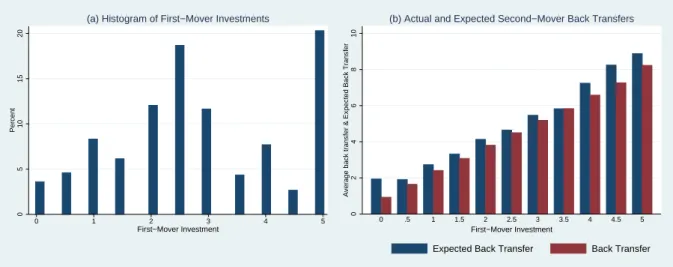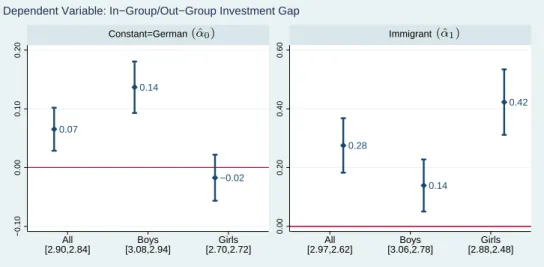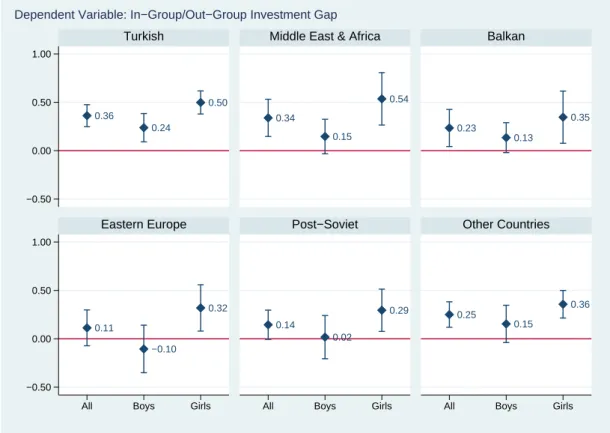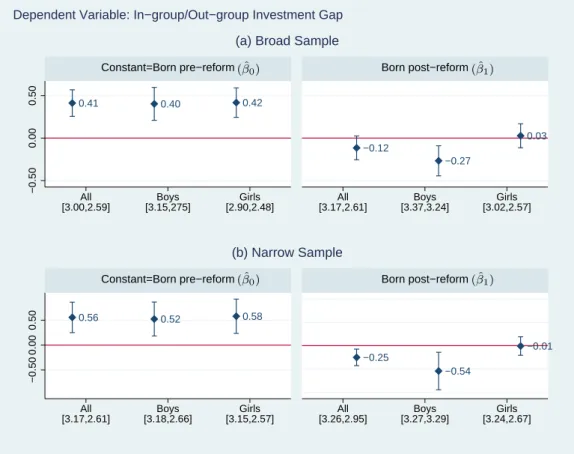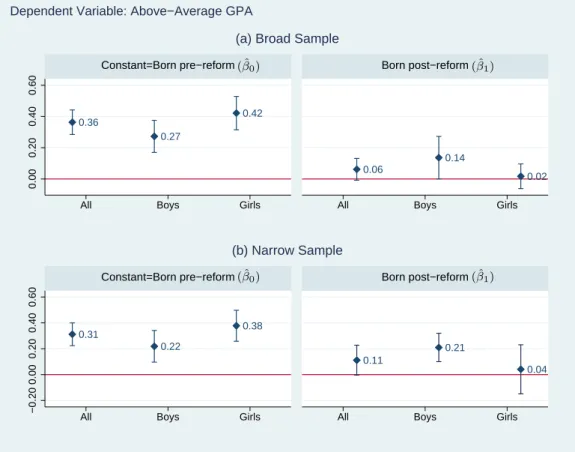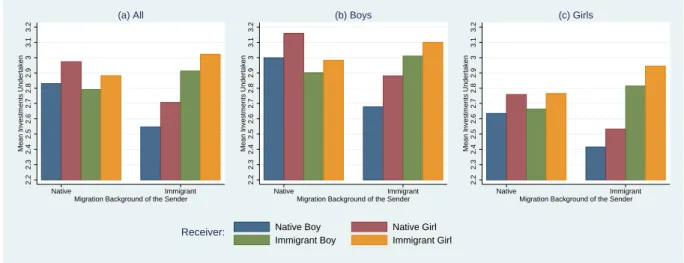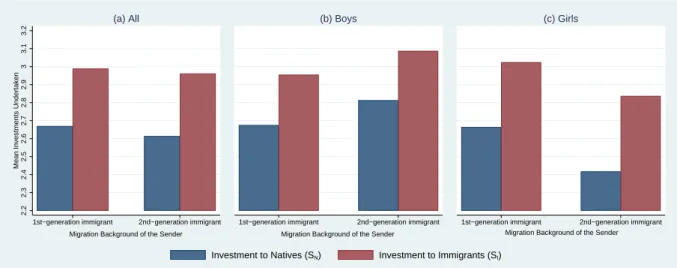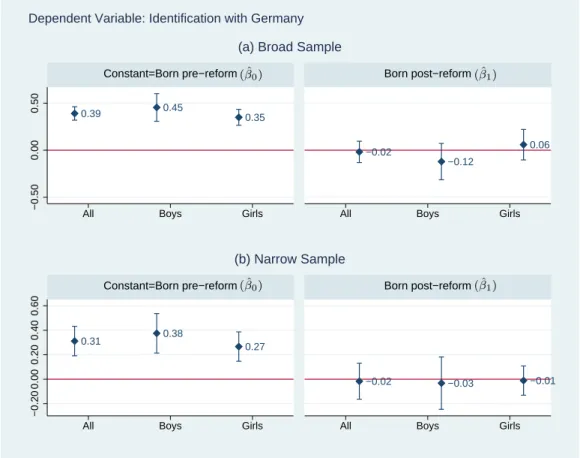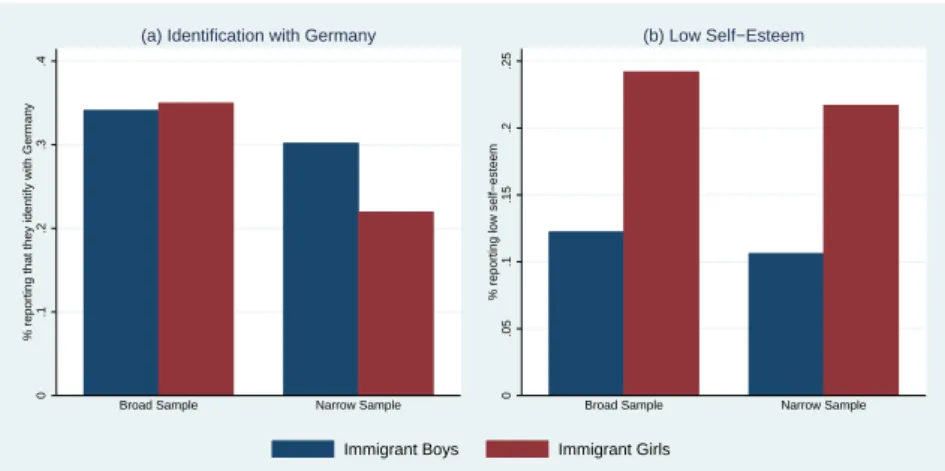IHS Economics Series Working Paper 340
April 2018
More Opportunity, More Cooperation? The Behavioral Effects of Birthright Citizenship on Immigrant Youth
Christina Felfe Martin G. Kocher Helmut Rainer Judith Saurer Thomas Siedler
Impressum Author(s):
Christina Felfe, Martin G. Kocher, Helmut Rainer, Judith Saurer, Thomas Siedler Title:
More Opportunity, More Cooperation? The Behavioral Effects of Birthright Citizenship on Immigrant Youth
ISSN: 1605-7996
2018 Institut für Höhere Studien - Institute for Advanced Studies (IHS) Josefstädter Straße 39, A-1080 Wien
E-Mail: o ce@ihs.ac.atffi Web: ww w .ihs.ac. a t
All IHS Working Papers are available online: http://irihs. ihs. ac.at/view/ihs_series/
This paper is available for download without charge at:
https://irihs.ihs.ac.at/id/eprint/4613/
More Opportunity, More Cooperation? The Behavioral Effects of Birthright Citizenship on Immigrant Youth∗
Christina Felfe, Martin G. Kocher, Helmut Rainer, Judith Saurer, Thomas Siedler†
April 2018
Abstract: Inequality of opportunity, particularly when overlaid with racial, ethnic, or cultural differ- ences, increases the social distance between individuals, which is widely believed to limit the scope of cooperation. A central question, then, is how to bridge such divides. We study the effects of a major citizenship reform in Germany—the introduction of birthright citizenship on January 1, 2000—in terms of inter-group cooperation and social segregation between immigrant and native youth. We hypothesize that endowing immigrant children with citizenship rights levels the playing field between them and their native peers, with possible spill-overs into the domain of social interactions. Our unique setup connects a large-scale lab-in-the-field experiment based on the investment game with the citizenship reform by exploiting the quasi-random assignment of citizenship rights around its cut-off date. Immigrant youth born prior to the reform display high levels of cooperation toward other immigrants, but low levels of cooperation toward natives. The introduction of birthright citizenship caused male, but not female, im- migrants to significantly increase their cooperativeness toward natives. This effect is accompanied by a near-closure of the educational achievement gap between young immigrant men and their native peers.
JEL Codes: C93, D90, J15, K37.
∗We thank Joshua Angrist, Natalia Danzer, Thomas Dohmen, David Figlio, Timo Hener, Albrecht Glitz, Stephen Jenkins, Lucinda Platt, Carmit Segal, Steven Stillman, Uwe Sunde, Roberto Weber and numerous seminar and conference participants for useful comments. We wish to thank almost 20 research assistants and interns for their invaluable assistance with data collection and preparation. All errors remain our own.
†Author affiliations and contacts: Felfe (University of St. Gallen, CESifo, christina.felfe@unisg.ch), Kocher (University of Vienna, IHS Vienna, University of Gothenburg, kocher@ihs.ac.at), Rainer (University of Munich, ifo Institute, CE- Sifo, rainer@econ.lmu.de), Saurer (ifo Institute, saurer@ifo.de), Siedler (Universit¨at Hamburg, Thomas.Siedler@wiso.uni- hamburg.de)
I. Introduction
Immigration has shaped, and continues to shape, many nations. This brings with it the challenge of integrating immigrants and their children into society. Among economists, one important take on integration—and on policies that promote it—is to emphasize convergence in the outcomes of immigrants and those of the host population in economic dimensions such as educational attainment and labor market participation (Card and Krueger [1992]; Alganet al.[2010]; Sweetman and van Ours [2014]).
Another fundamental, but much less scrutinized, aspect of integration pertains to social interactions be- tween immigrants and natives. Many such interactions, from everyday private exchanges to the provision of neighborhood amenities to working in teams, are not governed by enforceable contracts. Therefore, they almost always involve conflicts of interest and hold-up problems, and socially-efficient outcomes will only be achieved if people are willing to cooperate.
However, socioeconomic differences between immigrants and natives can act as a barrier to cooperation.
For example, economic inequality or social exclusion—particularly when overlaid with racial, ethnic, or cultural differences—increases the social distance between individuals, which is widely believed to limit the scope of cooperation (Hoffmanet al.[1996]). It is also conceivable that individuals from disadvantaged groups adopt oppositional identities, which is said to involve “anti-social” behavior (Akerlof and Kranton [2000]). Thus, to think clearly about integration interventions, it is not enough to know about their impact in terms of educational or occupational outcomes; we should also be concerned about their potential in fostering cooperation between individuals of diverse backgrounds and perspectives.
To examine this issue, this paper zooms in on one fundamental mechanism for immigrant inclusion.
Specifically, we study the effects of a major citizenship reform in Germany—the introduction ofbirthright citizenship on January 1, 2000—in terms of inter-group cooperation and social segregation between immigrant and native youth. Our unique setup combines the advantages of experimental economics in studying in-group/out-group phenomena (Fershtman and Gneezy [2001]; Chen and Li [2009]) with the way in which labor economists have come to frame causal questions. In particular, we (i) conducted an incentivized lab-in-the-field experiment based on the investment (or “trust”) game with a sample of nearly 4,500 adolescents;1 (ii) allowed participants to condition their strategies on the identity of their opponents; (iii) linked the experimental data with information from an extensive socioeconomic survey;
and (iv) chose a sample design that allows us to connect the experiment with the citizenship reform using quasi-experimental identification strategies.
Birthright citizenship—the rule that all children born on a nation’s soil obtain citizenship at birth—is subject to much controversy. For example, when Donald Trump became the first major U.S. presidential contender to endorse ending birthright citizenship, some saw it as an effective way of containing illegal immigration and birth tourism.2 Yet others rallied to point out that birthright citizenship is one of the most powerful mechanisms of social inclusion (National Academies of Sciences, Engineering, and Medicine [2015]). This controversy, and similar debates in Europe, is surprisingly uninformed by reliable evidence from countries that have changed their approach to birthright citizenship.
We exploit such a change and take a first step towards tracing its impact on the lives of young im- migrants. Our main idea is as follows. Birthright citizenship endows immigrant children with the host country’s nationality at birth and, thus, with the same legal rights, and the attendant political and eco- nomic opportunities, as their native counterparts. The existing literature suggests that this could have
1As will be explained in more detail below, we have avoided selection in and attrition from the experiment by running it in 219 classes of 57 German schools during regular school hours in the final year of compulsory schooling. Throughout, we will use the terms children, youth and adolescents interchangeably to refer to the participants in our study.
2See, for example, a CNN article dated 18 August 2015, “Birthright citizenship: Can Donald Trump change the con- stitution?” (http://edition.cnn.com/2015/08/18/politics/birthright-citizenship-trump-constitution/index.html, accessed Oct 10, 2017)).
had (at least) two relevant consequences: it might have induced immigrant parents to better integrate into the host society (Avitabile et al.[2013]); and it may have triggered human capital investments by immigrant parents, with positive effects on their children’s educational integration (Felfe et al.[2016]).
These effects contribute to levelling the playing field between immigrant and native youth and reduce the social distance between them. Therefore, we held the expectation that the introduction of birthright citizenship might have spilled over into the sphere of inter-group cooperation. We test this hypothesis among the first cohort of immigrant children affected by the reform in their final year of compulsory schooling, more than 15 years after the policy took effect.
The context of our study is Germany, the OECD’s second largest country of immigration after the United States (OECD [2014]). Currently, immigrant youth account for one-third of Germany’s children under the age of 15, and the largest minority group of youths, by far, are immigrant children of Turkish origin. Our own survey, as well as other household surveys, suggests that there are several major dividing lines between them and their native peers. The first is religion: the majority of native German children have a Christian religious affiliation, while Islam is the dominant religion among immigrant children.
Second, immigrant children are more likely than non-immigrant children to have parents with low educa- tional attainment and to grow up in low-income conditions. Third, a good deal of evidence also indicates that immigrant children are outperformed by their German peers along multiple indicators of academic achievement (Dustmannet al.[2012]). Thus, we are dealing with native and immigrant children who are strongly segmented in terms of cultural and social characteristics.
Our lab-in-the-field experiment builds on the pioneering work of Fershtman and Gneezy [2001], who used the investment game (Berget al.[1995]) to study non-market interactions between real social groups.
The advantage of using an incentivized experiment rather than a questionnaire is, as succinctly put by Fershtman and Gneezy [2001], that it captures people’s behavior and not what people claim or believe to be their own behavior. We take the investment game as a vehicle to measure the extent to which individuals of different social identities are willing to cooperate, and the version we implement is based on the following idea. In a segmented migration society such as Germany, “being a native” or “being an immigrant” are amongst the core attributes of individuals (next to gender) that determine their social identities. Moreover, these attributes are ubiquitous and easy to perceive, and therefore, they are likely to feed into social interactions. Thus, using the strategy-vector method (Selten [1967]; Falk and Zehnder [2013]), we allowed participants to condition their decisions on the gender and migration background of their opponents.3 Our main measure for intra- versus inter-group cooperation is the in-group/out-group investment gap that senders reveal in the first stage of the investment game. For natives it is the amount they send to other natives relative to the quantity they send to immigrants, while for immigrants it is the amount they send to other immigrants relative to the quantity they send to natives.
Based on the experiment, we obtain three insights that set the scene for our main question. First, the investment behavior of immigrant children, both boys and girls, reveals a marked gap between intra- and inter-group cooperation: on average, they transfer roughly 60% of their endowment to other immi- grants, while their investments to native German children are 13% lower. This difference is particularly pronounced among youth of Turkish origin, for whom we observe an in-group/out-group investment gap of more than 20%. Second, we show that immigrants’ low out-group cooperation is to a large extent explained by asymmetric other-regarding preferences toward immigrants and natives, and only to a small extent by asymmetric beliefs about whether their opponents will exploit them. This, together with the fact that immigrants’ low out-group cooperation involves a willingness to sacrifice money, suggests that immigrants’ cooperative decision making is shaped by parochial altruism (Choi and Bowles [2007]). Third, differently from immigrant youth, natives effectively cooperate with both in-group and out-group mem-
3For example, in the first stage of the investment game, participants had to decide how much of their initial endowment to send to a boy/girl with German-born/foreign-born parents.
bers: on average, they transfer 58% of their endowment to other natives, and their out-group investments to immigrants are only marginally lower.
Having established this, we ask: Does birthright citizenship foster cooperation between immigrant and native youth? To that end, we exploit the following policy change. Until December 31, 1999, Germany granted birthright citizenship based onjus sanguinis (right of blood), i.e., only children born to German nationals received citizenship at birth. After January 1, 2000, the regime changed to a restricted version ofjus soli(right of soil), i.e., every child born on German territory gained a conditional right to German citizenship.4 This setting provides us with a birth date eligibility cut-off, which serves as our source of identification. In particular, exploiting the quasi-random assignment of birthright citizenship around the cut-off, we analyze whether the policy caused discontinuities in immigrant children’s propensity to cooperate with in-group and out-group members.
Our main finding is that the introduction of jus soli caused male, but not female, immigrants to significantly increase their cooperativeness towards natives. We observe an in-group/out-group investment gap of 15% for immigrant boys born pre-policy, while for those born underjus soli, it is 11 percentage points, or almost 70% lower. This effect is entirely driven by an increase in out-group cooperation.
Moreover, it is particularly pronounced for boys of Turkish origin: for those born pre-policy, the in- group/out-group investment gap amounts to 20%, which completely vanishes for those born post-policy.
For immigrant girls, the birth date cut-off does not matter at all: among those born pre-policy, investments to immigrants exceed investments to natives by 17%, and this difference persists for those born post- policy. Several robustness checks corroborate these results.
Finally, we explore possible explanations for the reform effect and question why it is gender-specific.
For immigrant boys, we find that the policy not only cause more cooperation with natives; it also led to a near-closure of a substantial pre-existing educational achievement gap between them and their native peers. Thus, education relative to natives appears to be an important factor in immigrant boys’ in- group/out-group cooperation and is our main explanation for the reform effect on out-group cooperation.
This explanation, however, does not hold for girls: those born pre-policy were not lagging much behind their native female peers educationally, but nevertheless were unwilling to cooperate with them in the experiment; moreover, the policy did not change this picture.
This raises an intriguing question for future research: What explains immigrant girls’ low out-group cooperation and the lack of an effect of increased opportunities? Although our study was not set up to address this unanticipated (by us) result, we take some first steps to explore it. Across many immigrant groups, girls are socialized to be “keepers of the culture”. The existing literature suggests that this may have two relevant consequences: immigrant girls are more likely than immigrant boys to self-identify with their parents’ immigrant origins; and they are more likely to face high levels of parent-child conflict and, consequently, to have lower self-esteem. To the extent that high ethnic self-identification and low self-esteem have been linked to out-group discrimination (Hogg and Abrams [1990]; Rubin and Hewstone [1998]), we consider these as plausible explanations for the gender-specific patterns we have uncovered.
Based on our survey, we provide descriptive evidence that is consistent with these explanations.
Our study relies on a novel combination of a lab-in-the-field experiment with a natural experiment and provides novel insights into the interface between immigration, citizenship and inter-group cooperation.
It builds upon and connects a number of papers that span the fields of experimental economics, labor economics, and political science. Our experimental design is an outgrowth of ideas developed by Fersht- man and Gneezy [2001]. In their experiments with Ashkenazi (Eastern) and Sephardi (Western) Jews in Israel, they find systematic discrimination towards men of Eastern origin. Inspired by this work, there
4As further detailed below, the conditionality attached tojus soli, fulfilled by a large majority of immigrant families at the time of the reform, was that at least one parent had been a legal resident in Germany for eight years or more at the time of birth of the child.
has developed a small but active stream of literature in experimental economics on cooperation, trust, and discrimination between immigrants and natives. For instance, Guillen and Ji [2011] focus on do- mestic university students and their Asian international peers in Australia; Cox and Orman [2015] study first-generation immigrants and native-born Americans in the United States; and Cettolin and Suetens [2017] address non-Western immigrants and native Dutch in the Netherlands. A study that is close in spirit to ours is Albrecht and Smerdon [2016]. They exploit a refugee resettlement to a small rural town in Australia to study the effects of a migration shock on social capital. Combining trust data from an lab-in-the-field experiment with survey data from both treatment and similar control towns, they find that citizens in the treated town (i.e., who experienced the refugee resettlement) trust refugees relatively more than those in untreated towns.
Our study connects the literature described above with a number of studies in labor economics and political science that explore the effects of citizenship on immigrants. Chiswick [1978] was among the first to analyze the effect of Americanization on the earnings of foreign-born men. More recent contributions have focused on the effects of citizenship on wage growth (Bratsberg et al. [2002]; Steinhardt [2012]), employment prospects (Foug`ere and Safi [2009]; Gathmann and Keller [2017]) and remittances (Piracha and Zhu [2012]). Hainmuelleret al. [2017] exploit the quasi-random assignment of citizenship in Swiss municipalities that used referendums to decide on the naturalization applications of immigrants. Their main finding is that receiving the host country’s nationality strongly improves immigrants’ long-term social integration. Turning to the effects of birthright citizenship, there is evidence that immigrant parents are more likely to stay in the host country and to interact with the local community if their children are entitled to the host country’s nationality at birth (Avitabileet al.[2013]; Sajons [2016]). In a previous paper, a subset of us (Felfeet al.[2016]) found that the introduction of birthright citizenship in Germany had positive effects on immigrant children’s educational outcomes both in the short and the long term. Avitabile et al. [2014] report that birthright citizenship leads to a reduction in immigrant fertility and improved health outcomes for immigrant children.
The remainder of the paper is structured as follows. In Section II, we focus on the lab-in-the-field experiment: first we describe our setting, sample and experimental design; then, we provide basic results on intra- and inter-group cooperation among Germany’s youth. Section III connects the lab-in-the-field experiment with the natural experiment of Germany’s introduction of birthright citizenship. It begins with a description of the institutional background and empirical strategy, followed by the main results on the reform effect and its possible explanations. Section IV concludes by offering some thoughts on policy implications and directions for future research. Three Appendices collect additional material.
II. The Lab-in-the-Field Experiment
II.A. Study Design
Our study took place between June and November 2015 and was conducted in 219 classes of 57 German schools during regular school hours. At the time of the experiment, all participants were in their final year of compulsory schooling, and thus 15 to 16 years of age at the time of the study.
Setting, Subject Pool, and Sample Description
The study was run in two German federal states: Schleswig-Holstein (SH), where the duration of com- pulsory schooling is nine years; and North Rhine-Westphalia (NRW), where compulsory education lasts for ten years. In both federal states, a school year starts in August/September and ends in June/July.
There were two waves of data collection. In the first wave, lasting from June 2 to July 16, our target population were all 9th graders from 31 schools (spread over 122 classes) in six cities of SH.5In the second wave, lasting from October 19 to November 16, we targeted all 10th graders of 26 schools (spread over 97 classes) in two cities of NRW.6 Our chosen target populations allow us to focus on a school cohort composed of children mainly born in 1999 and 2000. This, in turn, will be crucial for identifying the effects of a major German citizenship reform that took effect on January 1, 2000 and saw the introduction of birthright citizenship.
In both SH and NRW, we sought approval for our study by submitting the design and a list of target schools to the respective ministries of education. Both ministries approved the study and strongly en- couraged the principals of the targeted schools to participate. Upon approval, we contacted the principals directly and asked for formal permission to conduct the experiment and survey in all classes of grade nine in SH and in all classes of grade ten in NRW. The 57 participating schools belong to five school types: ten schools are secondary general schools (“Hauptschule”); eight are intermediate schools (“Realschule”); 29 are comprehensive schools without the final years of grammar school-type education (“Gesamtschule ohne gymnasialer Oberstufe”); eight are comprehensive schools with the final years of grammar school-type education (“Gesamtschule mit gymnasialer Oberstufe”); and two are grammar schools or high schools (“Gymnasium”). Two weeks prior to the study, school principals informed parents about the study and gave them an opt-out option, i.e., parents could proscribe their children’s participation.7 Moreover, immediately before the experiment started, all students present in class were informed by us that partic- ipation was voluntary. The experiment was run at the school class-level during two regular consecutive school hours.
On the days we conducted the study, a total of 4,634 students were present in the 219 classes. Parents made use of the opt-out option for 44 of them (less than 1%), while 154 students (3.5%) chose to opt out themselves. Thus, 4,436 students participated in the study. Of those, 133 participants did not fully complete the experimental task, while 226 did not provide the survey information necessary for our basic analysis (i.e., own gender and/or parental migration background). This leaves us with a baseline sample of 4,077 students.
The study consisted of two parts, the investment game (described in detail below) and an extensive socioeconomic survey. Each part lasted approximately one school hour (45 minutes), and the order of the two parts was randomized on a daily basis in order to avoid any potential bias stemming from that sequence.8 The study was conducted in regular classrooms and was done by paper and pen. To guarantee privacy, we installed mobile privacy screens between students.9 We ensured anonymity by assigning a unique identity code to each participant.
The survey provides information,inter alia, about participants’ date of birth, country of birth, gender, school achievements, aspirations, preferences and interests, personality traits, and family background.
Two key family background variables are the birth places of both parents, which we use to categorize participants into three groups: (i) native children, whose parents are both German-born; (ii) immi- grant children, whose parents are both foreign-born; and (iii) mixed-background children, who have one German-born and one foreign-born parent. Overall, according to our definitions, the sample comprises 2,201 native children (54%), 1,218 immigrant children (30%) and 658 mixed-background children (16%).
Roughly 77% of all immigrant children in our sample are German-born (i.e., second-generation immi-
5The cities are Flensburg, Kiel, L¨ubeck, Neum¨unster, Elmshorn, and Pinneberg, with population sizes ranging from 42,266 in Pinneberg to 246,306 in Kiel.
6The cities are Duisburg and Wuppertal, with population sizes of 491,231 and 350,046, respectively.
7Parents were, however, not informed about the objectives of the study.
8Because none of our experimental results depends qualitatively on the order of events in the session (i.e., whether the survey or the experiment was conducted first), we pool the data of the two types of sessions in the analysis.
9See Figure B.1 in Appendix B for a photo of a classroom setup.
grants), while 23% are foreign-born (i.e., first-generation immigrants).
We focus on native and immigrant children, while discussing results for mixed-background children only in passing. Thus, the following sample description is confined to the former two groups (for details, see Appendix Table A.1). In Germany, the largest minority group of youths, by far, are immigrant children of Turkish origin. This is also evident in our sample. Specifically, 38% of immigrant children have parents who are Turkish-born, 14% have Middle-Eastern or African backgrounds, 12% have parents born in a post-Soviet country, 11% have parents from a Balkan country, 11% have Eastern European backgrounds, and 14% come from other countries. A comparison of native and immigrant children suggests several marked differences, of which we mention four. First, roughly one-third of immigrant children have parents with low educational attainment, while the corresponding share for native children is just under one-fourth.10 Second, immigrant children are more likely than non-immigrant children to live in two-parent households (74% vs. 55%). Third, the majority of native children report a Christian (i.e., Catholic or Protestant) religious affiliation (67%), while the group of immigrants is predominantly made up of Muslim children (59%). Finally, 69% of immigrant children report that they speak a language other than German with their parents at home. We interpret this evidence as reflecting the pronounced cultural, social and economic gaps between native and immigrant children that are also observed in representative surveys.
The Investment Game: Design and Implementation
Our experiment is based on the standard investment game (Berg et al. [1995]), which consists of two players, called the first-mover (sender) and the second-mover (receiver). Each player is endowed with five euros at the beginning of the game. The first-mover decides on the amount to be sent to the second- mover (x∈[0,5]) in steps of 50 e-cents. The transferred amount is then tripled by the experimenter.
The second-mover is informed about the first-mover’s decision and the transferred amount (3x) and can then decide whether to send back any amounty∈[0,5 + 3x] to the first-mover. The final payoff for the first-mover is 5−x+y and for the second-mover is 5 + 3x−y. The only subgame-perfect equilibrium prescribes no investment and zero returns, while the social optimum involves “full” cooperation, i.e., the first-mover invests his entire endowment.
In our experiment, we employed the strategy method, i.e., each participant had to decide as first- mover and as second-mover. Moreover, and most importantly for the purpose of this paper, we allowed first-movers to condition their investment decisions on the gender and migration background of possible interaction partners. We implemented this by letting first-movers decide whether, and if so, how much, to transfer to each of six possible receiver types (indexed byk): a boy with German parents (S1), a girl with German parents (S2), a boy with foreign parents (S3), a girl with foreign parents (S4), a boy with foreign parents who possesses German citizenship (S5), and a girl with foreign parents who possesses German citizenship (S6).11 In principle, this setup allows us to understand the extent to which cooperation is dependent on migration background as well as gender. However, the main task this paper sets itself is to examine intra- and inter-group cooperation between native and immigrant youth and how it is influenced by public policy. We will therefore largely abstract away from cooperation conditional on gender, apart from remarks, when deemed necessary. Thus, we collapse the six choices{S1, ..., S6} into two variables:
a participant’s average investment to natives (SN) and his or her average investment to immigrants (SI),
10As Appendix Table A.1 also shows, a relatively large proportion of immigrant children report that they do not know their parents’ educational attainment.
11See Appendix B for the translated decision sheets.
defined as
SN = 1 2
2
X
k=1
Sk and SI =1 4
6
X
k=3
Sk.12
Throughout the paper, we refer to SN as native children’s in-group investments and as immigrant children’s out-group investments, respectively. Likewise, we refer to SI as native children’s out-group investments and immigrant children’s in-group investment, respectively. Our main measure for intra- versus inter-group cooperation is the in-group/out-group investment gap (IG) of senders with and without migration backgrounds. Formally, it is defined as
IG=
( SN −SI for native children;
SI−SN for immigrant children.
After participants had completed the first stage of the investment game, they were asked to indicate on their decision sheet the expected back transferEk ∈[0,20] from the six possible interaction partners in steps of tene-cents.13
At the final stage of the investment game, participants were asked to play the role of second-movers, and we employed the contingent response method to elicit their back transfers (returns). For example, on a first decision sheet, participants were asked to decide on their back transfers to a boy with German- born parents, contingent on the eleven possible investments of the boy as the first mover. Using the same strategy vector variant, we elicited back payments to the other five potential interaction partners.
Amounts between and including 0 and 5 + 3xin steps of tene-cents were allowed.
Before the experiment started, the instructions were distributed to all students in class and read out by an experimenter.14 Students were informed that they would first play the investment game as the first-mover and thereafter as the second-mover. They were told that they could earn real money and that their payoffs would depend on their own choices and those of another, randomly assigned experiment participant from a different school.15 The average payoff in the experiment wase7.26.16 Participants received their payoffs no later than two weeks after the experiment took place (in envelopes with their unique identity codes, distributed by school secretaries or head teachers), which was known to them at the beginning of the experiment. All participants faced exactly the same decision tasks, instructions, and payoffs, and all procedures described here were common knowledge.
12Receiver typesk∈ {3,4}capture all immigrants (i.e., boys and girls with foreign parents), while receiver typesk∈ {5,6}
capture only the subset of naturalized immigrants (i.e., those who possess German citizenship). The reason we have allowed for this distinction will become clear in Section III, where we examine the effects of the German citizenship reform. For our main results, we have chosen not to drop any data, and hence, we computeSI by averaging over their investments to receiver typesk∈ {3,4,5,6}. That said, our results do not hinge on this specification, i.e., they remain qualitatively unchanged when we computeSI by averaging over participants’ investments to receiver typesk∈ {3,4}, i.e., by letting SI= 12(S3+S4).
13We chose not to incentivize the elicitation of expectations for reasons of practicality. We thus have to interpret the results based on expectations cautiously.
14The translated instructions can be found in Appendix B. All sessions were conducted by one leading experimenter—in most cases, one of the authors—and one or two students assistants, previously trained by us. The experiment followed a strict protocol that was obeyed in every session.
15To be precise, we calculate final payoffs as follows: (i) we randomly match two participants from two different schools; (ii) we randomly assign the roles of first-mover and second-mover; (iii) we determine the true typekof both the first-mover and the second-mover based on survey information on own/other gender and whether parents are German-born or foreign-born;
(iv) we implement the first-mover’s decision for the true type of the second-mover; (v) we implement the second-mover’s back transfer for the true type of the first-mover and his or her choice implemented in step (iv); and (vi) based on the pair of choices implemented in steps (iv) and (v), we calculate the participants’ final payoffs. When we implemented this procedure to calculate participants’ payoffs, we treated mixed-background children as children with foreign-born parents for pragmatic reasons. The question of the treatment of mixed-background children in the matching procedure was not raised by participants.
16The maximum payoff wase20. For participants whose payoffs were lower than e2, we paid out an unannounced consolation prize ofe2.
While decisions might potentially be different between our strategy vector variant and an alternative direct response method, we are confident that our results do not reflect an experimenter demand effect to discriminate or a social desirability bias not to discriminate. First, monetary incentives are substantial and should dominate other considerations. Indeed, data from the representative German Socio-Economic Panel suggest that the average payout in the experiment corresponds to more than 70% of the average amount of weekly pocket money given to adolescents with roughly the same characteristics as our partici- pants. Second, our main results in Section III show that immigrants’ intra- versus inter-group cooperation in the investment game is linked to an exogenous event, the introduction of birthright citizenship 15 years before our experiment took place, which is difficult to explain with an experimenter demand effect or a social desirability bias.
II.B. Results of the Lab-in-the-Field Experiment
In this subsection, we present basic results from our lab-in-the-field experiment. To that end, we exploit our full baseline sample, which contains the experimental choices of 4,077 participants.
General Investment and Back-Transfer Patterns
We begin with a brief description of general investment and back-transfer patterns. Panel (a) in Figure 1 shows a histogram of all investment decisions in the experiment. On average, first-movers investe2.85, or 57% of their initial endowment. The two most frequent investment choices are transfers of respectively 50 and 100% of the initial endowment. These investment patterns are comparable to what has been observed in previous experiments based on the investment game.17
Panel (b) in Figure 1 shows (i) averages of second-mover back transfers for each possible first-mover investment and (ii) average expected back transfers, conditional on the first-mover’s investment. It is apparent that second-movers show reciprocal behavior, on average: the higher the first-mover investments, the higher the back transfers. The degree of reciprocity appears to be quite high. For example, second- movers are willing to send back approximatelye4.50 if they receivee2.50 from first-movers, which almost equalizes final payments. Over the whole range of investments, the ratio of paybacks to investments estimated from an OLS regression is 1.42. Finally, Panel (b) also reveals that, on average, the level of actual back transfers matches first-movers’ expectations about back transfers almost one-to-one, especially for intermediate investments.
In-Group/Out-Group Investment Gaps
We now ask whether the migration background of interaction partners affects the investment decisions of first-movers. For the main part of the analysis, we restrict our sample to native German children (i.e., both parents German-born) and their immigrant peers (i.e., both parents foreign-born). At the end of the section, we briefly discuss the experimental choices of mixed-background children (i.e., one native and one foreign-born parent).
Figure 2 illustrates the investment choices of native and immigrant children by migration background of second-movers, both for the entire sample and separately by gender. Several interesting patterns emerge. First, for native adolescents, the evidence speaks against a strong pattern of unequal treatment of natives and immigrants. In the full sample [Panel (a)], natives’ in-group investments exceed their out- group investments by a statistically significant 2.1% (SN = 2.90, SI = 2.84; paired t-test withp < .01).
17For example, the distribution of first-mover investments is quite comparable to that in Falk and Zehnder’s [2013]
experiment in the city of Zurich, which was run with adults.
Looking at this result separately by gender [Panels (b) and (c)], we observe that there is no in-group/out- group variation in the investment choices of native girls (SN = 2.70, SI = 2.72). Native boys, by contrast, reveal moderate in-group favoritism: their in-group investments exceed their out-group investments by a statistically significant 4.8% (SN = 3.08, SI = 2.94;p < .01). Second, among immigrant children [Panel (a)], we detect a strong bias against natives that manifests itself in a statistically significant in-group/out- group investment gap of 13.4 percent (SI = 2.97, SN = 2.62,p < .01). The subgroup results by gender [Panels (b) and (c)] suggest that this gap is more pronounced for immigrant girls (16.1%;p < .01) than for immigrant boys (10.1%;p < .01).18 In Figure 3, we look at investment decisions in terms of propensities to strongly discriminate between in-group and out-group opponents. To do so, we classify participants as strong discriminators if their average in-group investments exceed their average out-group investments by 25% or more. The results are quite striking. It can been seen that roughly one-in-three immigrant children (31.4%) are strong discriminators, while the corresponding share among native children is only half that (15.6%). This pattern is more pronounced among girls (32.7 v/s 12.1%) than among boys (30.2 v/s 18.6%).
As a regression analogue to the just-described results, we next run the following simple specification:
IG =α0+α1Immigrant +ε. (1)
The dependent variable is defined for each first-mover as the difference between average in-group invest- ment and average out-group investment. Immigrant is a binary variable indicating whether a child has parents who are both foreign-born; the omitted category is native children, i.e., those whose parents are both German-born. Standard errors are clustered by school type and school location.
Figure 4 presents OLS estimates of Equation (1). In the full sample (labeled “All” on the x-axis), the mean of the in-group/out-group investment gap ise0.07 for native children, while for immigrants, it is a statistically significante0.28 higher. Among native boys, the in-group/out-group investment gap amounts toe0.14, while for immigrant boys, it is exactly twice as high, with the difference being signifi- cant at the 1% level. For native girls, the in-group/out-group investment gap is both quantitatively and statistically indistinguishable from zero (e-0.02), while for immigrant girls it is a statistically significant e0.42 higher.
The main message so far is that the scope for cooperation between immigrants and natives is limited because immigrants, although showing a high willingness to send money to other immigrants, have a low inclination to invest towards natives. Why is this the case? In the investment game, there are typically two underlying motives for cooperation: the sender’s beliefs about whether her choice to cooperate will be exploited by opponents and individual preferences such as other-regarding concerns and risk aversion (see, e.g., Karlan [2005]; McEvilyet al. [2012]; Sapienzaet al. [2013]). As describe in Section II.A, we have elicited the expectations of senders regarding the back-transfer behavior of receivers. Moreover, given that we have employed the strategy method, we can use individuals’ behavior as receivers as an indication of their other-regarding preferences. Finally, our survey contains a question on risk attitudes.
Thus, we are able to examine the extent to which the investment behavior of senders is driven by these three factors.
For brevity, we relegate the details of this analysis to Appendix C and summarize the two main findings here. First, we run a simple regression of participants’ in-group investments on measures of their risk attitudes, their social preferences towards in-group members, and their beliefs about in-group members’ tendency to exploit them. This exercise reveals that senders’ in-group behavior is driven both
18In Appendix Figure A.1, we show how the migration backgroundand gender of game partners affects the investment decisions of first-movers. Both children with and without migration backgrounds appear to positively and in almost equal measure differentiate between native girls and native boys and immigrant girls and immigrant boys, respectively.
by beliefs and social preferences, which is in line with the findings of Sapienzaet al.[2013]. Second, we regress the in-group/out-group investment gap on measures that capture in-group/out-group differences in participants’ beliefs and preferences. The main finding is that immigrants’ in-group favoritism is to a large extent explained by differences in other-regarding preferences toward in-group and out-group members and only to a small extent by asymmetric beliefs. In Appendix C, we also show that, in our experiment, being matched with out-group opponents involves a loss of money, compared to being matched with in-group opponents. For immigrants, these losses are almost exclusively explained by their own in-group favoritism as first-movers. For natives, the payoff losses are largely due to the fact they receive lower back transfers from immigrant than from native opponents. Taken together, since immigrants’ low out-group cooperation has a preference-based explanation and involves a willingness to sacrifice money, one might describe their social exchange behavior as being shaped by parochial altruism (Choi and Bowles [2007]).
Heterogeneity
We now examine heterogeneity in in-group favoritism across immigrant groups. To that end, we re- run Equation (1) with the variable Migrant replaced by dummy variables for six mutually exclusive groups of immigrant children. The first group (Turkey; 461 observations) comprises immigrant children of Turkish origin—by far the largest minority group of youths in Germany. In the second group (Middle East & Africa; 280 observations), we pool together immigrant children with Middle-Eastern and African backgrounds. The third group (Balkan, 137 observations) is made up of immigrant children whose parents come from a Balkan country. The fourth group contains immigrant children with an Eastern European background (Eastern Europe; 130 observations), while the fifth group is made up of immigrant children whose parents come from a post-Soviet country (Post-Soviet; 130 observations). The final, miscellaneous group (Other Countries, 176 observations) contains all other immigrant children.
Figure 5 shows that the most pronounced above-average in-group favoritism occurs among immigrant children of Turkish origin.19 In particular, while the in-group/out-group investment gap for German native children amounts toe0.07 (Boys: e0.14; Girls: e-0.02; see Figure 4), it ise0.36 (Boys: e0.24;
Girls: e0.50) higher for children with Turkish-born parents. The second group of immigrants that displays above-average in-group favoritism are children with Middle Eastern and African backgrounds, followed by those whose parents originate from Balkan countries. By contrast, immigrant children whose parents come from Eastern European and Post-Soviet countries reveal a below-average in-group/out- group investment bias.20 F-tests on the equality of the estimated coefficients on the dummiesTurkeyand Eastern European reject equality at p-values of 0.01 (full sample) and 0.02 (boys), but not for girls with a p-value of 0.11. A comparison of the estimated coefficients on the dummiesTurkeyandPost-Soviet yields a qualitatively similar conclusion. What is noticeable about these results is that the three strongly in- group biased immigrant groups share the characteristic that they are predominantly made up of children with a Muslim background (Turkey: 92%, Middle East & Africa: 75%, Balkan: 68%). By contrast, the religious background of immigrant children with an Eastern European or post-Soviet background—with shares of Christians of 84% and 61%, respectively—is quite comparable to that of native German children (67%).
Two final points should be made about the analysis so far. First, we have focused on comparing the experimental choices of immigrant and native children, but we have been silent on the behavior of children with mixed-backgrounds. Appendix Figure A.2 reveals that mixed-background children also favor immigrants over natives when choosing to cooperate (SI = 2.88; SN = 2.69; gap 7.1%;p < .01),
19Note that we do not report estimates of the constant here, which remain the same as in Figure 4.
20The in-group/out-group investment gap of boys from these two immigrant groups is identical to or even lower than that of German native boys.
but to a lesser extent than immigrant children and with less-pronounced gender differences. Second, in discussing the choices of children with migration backgrounds, we have made no distinction between first-generation (i.e., foreign-born) and second-generation (i.e., German-born) immigrant children. Our empirical strategy in the next section requires us to narrow our sample to second-generation immigrant children. Appendix Figure A.3 shows that the the degree of in-group favoritism that we identified in the investment game does not differ markedly between first- and second-generation immigrant children.
III. The Natural Experiment
This section turns to the main question posed at the outset: can governments of immigrant-receiving countries foster cooperation between immigrants and natives through policy interventions? We address this question by analyzing how one important mechanism of immigrant inclusion—birthright citizenship—
affects the way in which immigrant children interact with their native peers.
III.A. Institutional Background: Jus Soli vs. Jus Sanguinis
The path to citizenship for immigrant children varies considerably across immigrant-receiving countries.
In the United States, any person born on the nation’s territory automatically gains U.S. citizenship, regardless of the nationality or immigration status of the person’s parents. This rule, based on jus soli (“right of soil”), has been in place since the 19th century and is commonly referred to as birthright citizenship. By contrast, many countries in Europe have granted citizenship at birth based upon the principle ofjus sanguinis (“right of blood”), meaning that citizenship is inherited through parents rather than determined by the place of birth. For children born to foreign nationals, this rule implies that citi- zenship can only be acquired through naturalization (i.e., upon application) later in life. Not surprisingly, in countries that havejus soli, virtually all native-born children of immigrants have the host-country na- tionality, while the lowest percentages of immigrant children with host-country nationality are found in countries that adhere tojus sanguinis (OECD [2011]).
The context of our study is Germany, a country that has recently witnessed a switch fromjus sanguinis to jus soli. Throughout the 20th century, German citizenship could only be acquired by descent from a German mother and/or a German father. With the turn of the millennium, this principle of jus sanguinis was replaced by a conditional version ofjus soli. In particular, a child born to foreign parents after December 31, 1999, automatically acquired German nationality at birth if at that time at least one of his or her parents had been living in Germany habitually and legally for at least eight years. The reform substantially increased the portion of immigrant children who acquired German nationality by birth. In particular, for second-generation children born pre-policy, data from the German Microcensus suggest that roughly 20% qualified for citizenship at birth throughjus sanguinis. For second-generation immigrant children born post-policy, the same data source suggests that 71% were eligible for automatic birthright citizenship. Among children born to Turkish immigrants this share amounts even to 81%.
Thus, we think of immigrant children with a Turkish background as a high-eligibility treatment group.
The main mechanisms through which we believe the introduction of birthright citizenship could influ- ence the low out-group cooperation shown by immigrants is educational integration. As discussed earlier, the school performance of immigrant children in Germany lags behind that of their native counterparts.
In a previous paper, a subset of us (Felfeet al.[2016]) argued that the introduction of birthright citizen- ship in Germany increased the returns to education for immigrants21 and indeed found evidence for a
21There are several reasons for this. For example, in Germany, citizenship improves immigrant children’s future economic opportunities by giving them access to employment in the public sector. Evidence also suggests that having the host
positive human capital effect along a range of indicators of educational achievement and progress. This reform effect has reduced the distance between immigrant children and their native peers in the sphere of education, which might affect the extent of their out-group cooperation.22
III.B. Empirical Strategy: Exploiting the Natural Experiment
We consider the introduction ofjus soli in Germany on January 1, 2000, as an exogenous event that led to a quasi-random assignment of birthright citizenship among immigrant children. Since first-generation immigrant children (i.e., those born outside Germany) were unaffected by the reform, we exclude them from the analysis and only retain second-generation immigrant children (i.e., those born in Germany) for the estimation.
To isolate the effect the reform had on immigrant children’s behavior, in a first step, we compare the experimental decisions of second-generation immigrants born before and after January 1, 2000. In so doing, it is important to ensure that immigrant parents could not self-select into treatment. Since our source of identification is a birth date cut-off, the main concern is strategic fertility behavior. We address this issue in two ways. First, we restrict our sample to children born in the ±4-month window around January 1, 2000. This ensures that our sample only comprises children who were conceived before July 1999, the month in which the German citizenship reform was ratified. In robustness checks, we further narrow the window around the reform cut-off date. Second, we implement a “donut” strategy that drops children born in the±2-week window around January 1, 2000. This avoids potential selection into treatment through birth-date-manipulation by parents. Having imposed these sample restrictions, we examine the behavior of second-generation immigrant children born around the reform’s cut-off date by estimating the following simple regression model:
IG =β0+β1Born Post-Reform +ε, (2)
whereIGrefers to the in-group/out-group investment gap. The explanatory variableBorn Post-Reform is a binary variable indicating whether an immigrant child was born in the months before (=0) or after (=1) January 1, 2000. Estimates of the parameterβ0thus capture the in-group/out-group investment gap among immigrant children born pre-reform, while estimates ofβ1 show how the behavior of immigrant children born post-reform differs from the behavior of those born pre-reform.
A simple before-after comparison such as Equation (2) may be partly driven by the fact that immigrant children born after the policy change are always younger than those born before it. Moreover, it is possible that the characteristics of parents changes over the year (Buckles and Hungerman [2013]). If age or season of birth has an impact on immigrant children’s behavior, Equation (2) provides us with a biased estimate of the reform effect. To net out these potential biases, we construct a second difference between pre-policy and post-policy native German children (who were unaffected by the reform cut-off date) and estimate
country’s citizenship allows immigrants to earn higher wages (Chiswick [1978]; Steinhardt [2012]), to find jobs more easily (Foug`ere and Safi [2009]; Gathmann and Keller [2017]), and to steepen their wage-tenure profiles (Bratsberget al.[2002]).
Moreover, employers frequently face lower administrative costs if they wish to employ a naturalized person rather than a foreigner. Naturalization might also function as a signaling device for the employer for better integration, which in turn may influence immigrants’ bargaining power. Finally, it is conceivable that citizenship reduces the degree of discrimination against children with a migration background from the side of the teachers.
22In addition, other channels may play a role. For example, the acquisition of host-country nationality is seen by many as promoting immigrants’ identification with the host country, which may affect their behavior towards natives. It may also affect immigrants’ self-esteem, which has been linked to out-group discrimination (Hogg and Abrams [1990]; Rubin and Hewstone [1998]). Finally, natives may treat immigrants differentially based on their citizenship status, which may also affect the extend to which immigrants cooperate with natives. We will provide some evidence on the relevance of these channels in Section III.B.
